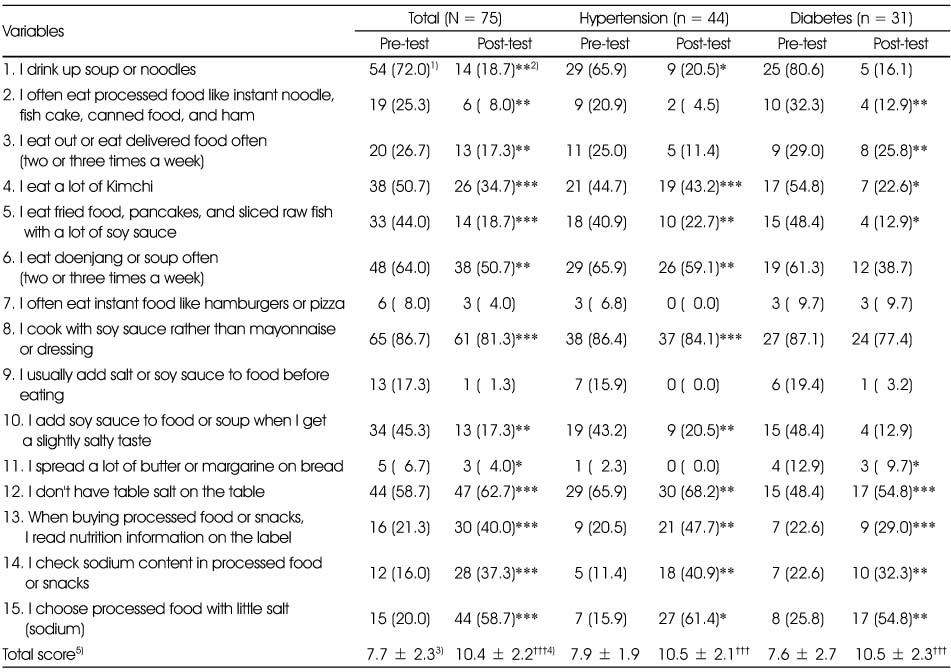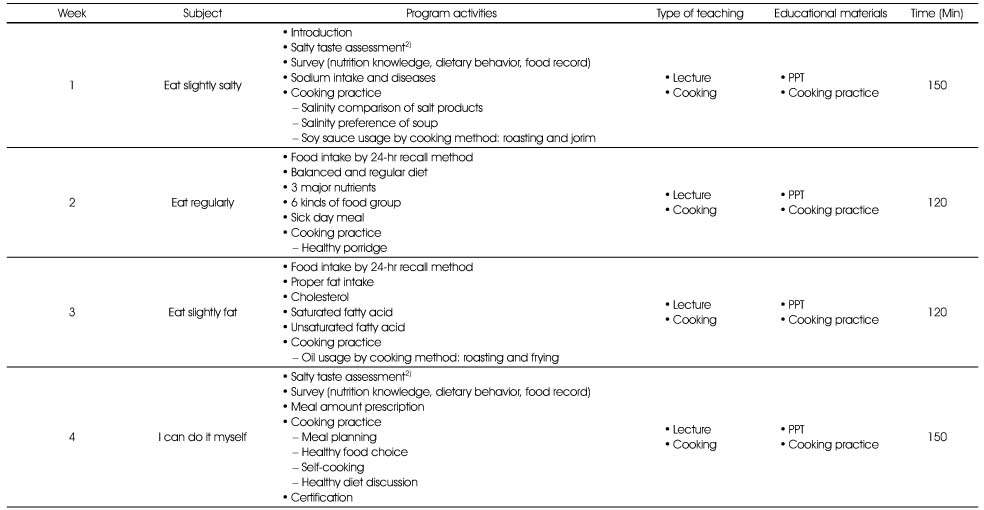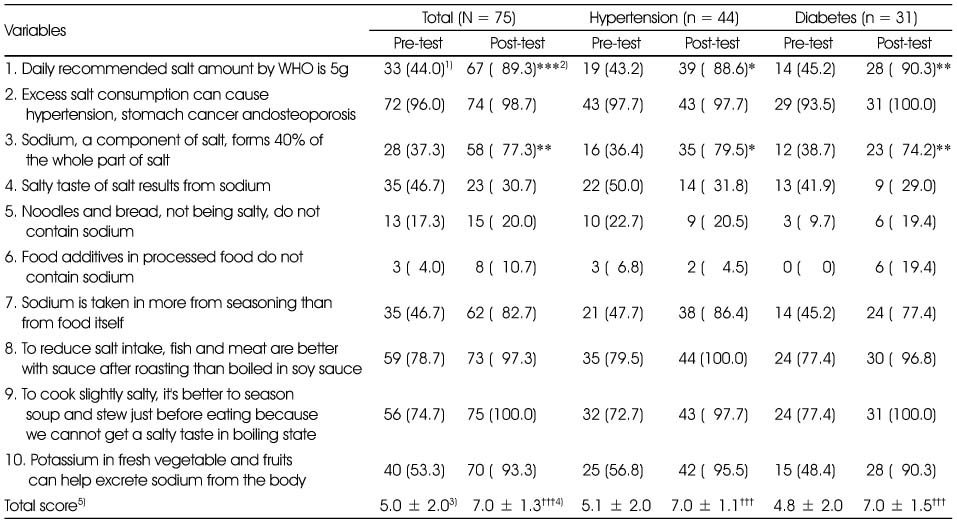Articles
- Page Path
- HOME > Korean J Community Nutr > Volume 16(5); 2011 > Article
-
Original Article
- Effects of Nutritional Education Practice Program for Cardiocerebrovascular High-risk Group at the Education Information Center
- Hang Me Nam, Seung Hee Woo, Young Ji Cho, Yun Jung Choi, Su Yeon Back, So Yeon Yoon, Jin Young Lee, Jung-Jeung Lee, Hye Jin Lee
-
Korean Journal of Community Nutrition 2011;16(5):580-591.
DOI: https://doi.org/10.5720/kjcn.2011.16.5.580
Published online: October 31, 2011
1KHyDDI (Korea Hypertension Diabetes Daegu Intiative) Project, Deagu, Korea.
2Division of Chronic Disease Control, Korea Centers for Disease Control & Prevention, Osong, Chungbuk, Korea.
3Department of Preventive Medicine & Public Health School of Medicine, Keimyung University, Daegu, Korea.
- Corresponding author: Hye Jin Lee, Korea Hypertension Diabetes Daegu Intiative Project 376-25 Samdeok-dong 3(sam)-ga, Jung-gu, Daegu 700-413, Korea. Tel: (053)428-0109, Fax: (053)422-9436, garden_1@hanmail.net
Copyright © 2011 The Korean Society of Community Nutrition
- 150 Views
- 0 Download
- 6 Crossref
Abstract
- This research was performed to investigate the effects of NEP (Nutritional Education Practice) program developed by KHyDDI (Korea Hypertension Diabetes Daegu Initiative) for hypertension and diabetes patients. The subjects were 116 patients (hypertension 70, diabetes 46) who had completed basic education program at the education information center and four-session program was implemented for them. Nutrient intake was analyzed and compared before and after the program by 24-hr recall method and evaluate weight, waist circumference, body fat, blood pressure and eating habits in terms of nutrition knowledge, eating behavior, salty taste assessment. The improved results after the program were observed in weight, waist circumference, body fat ratio, blood pressure, slightly salty taste in salty taste assessment, nutrition knowledge, eating behavior, sodium, energy, carbohydrate and protein intake ratio to total energy (p < 0.001). Therefore, this program is effective in the improvement of weight, waist circumference and eating behavior, and the continued management would lead to the prevention of cardio-cerebrovascular diseases in the community.
- 1. Daegu Metropolitan City. HyDDI(Hypertension Diabetes Daegu Initiative) Project Reports. 2007; Daegu Medical Association; 1-36.
- 2. Daegu Metropolitan City. KHyDDI(Korea Hypertension Diabetes Daegu Initiative) Project Reports. 2010; 15-17.
- 3. Jung YY, Shin EK, Lee HJ, Lee NH, Chun BY, Ann MY, Lee YK. Development and evaluation of a nutrition education program on sodium reduction in elementary school students. Korean J Community Nutr. 2009; 14(6): 746-755.
- 4. Kang HJ, Shin EM, Kim KW. Evaluation of nutrition education for diabetes mellitus management of older adults. Korean J Community Nutr. 2009; 14(6): 734-745.
- 5. Kim HH, Shin EK, Lee HJ, Lee NH, Chun BY, Ahn MY, Lee YK. Evaluation of the effectiveness of a salt reduction program for employees. Korean J Nutr. 2009; 42(4): 350-357.
- 6. Korea National Statistical Office. Deaths and causes of death in 2009. 2010.
- 7. Lee EH. The development and effects of therapeutic lifestyle change (TLC) program for the elderly with metabolic syndrome. 2010a; Ewha Womans University; Ph.D thesis.
- 8. Lee HJ. Development and evaluation of community education program for cardiocerebrovascular high-risk patients. 2010b; Kyungpook National University; Ph.D thesis.
- 9. Lee HJ, Kam S. Educational needs of elderly hypertensive or diabetes patients and educators for education program development of cardiocerebrovascular high-risk group. J Agric Med Community Health. 2010; 35(2): 177-192.
- 10. Lee JS, Lee WC, Lee KS, Koh KW, Choi EJ, Park CM. The new health promotion strategy in Japan-focusing on life-stylerelated diseases. J Korean Soc Health Educ Promot. 2008; 25(3): 167-181.
- 11. Lee KS, Kam S, Kim KY. Development of a comprehensive preventive maintenance measures cardiocerebrovascular disease, Youngnam University, Management Center for Health Promotion Project Reports. 2011; 1-16.
- 12. Merrill MD. First principles of instruction. Educ Tech Res Dev. 2002; 50(3): 43-59.
- 13. Ministry of Health Welfare. Report on 2008 National Health and Nutrition Survey. 2009; 50-53.
- 14. Moon EH, Kim KW. Evaluation of nutrition education for hypertension patients aged 50 years and over. Korean J Community Nutr. 2011; 16(1): 62-74.
- 15. Oh JY, Kim SB. Development and effects' analysis of nutrition education program for diabetes mellitus at community health center-focused on individual daily energy requirementsand food exchange units. Korean J Community Nutr. 2010; 15(4): 485-497.
- 16. Park HD, Kim EJ, Hwang MO, Paek YM, Choi TI, Park YK. Effects of workplace nutrition education program tailored for the individual chronic disease risks. Korean J Nutr. 2010; 43(3): 246-259.
- 17. Park YS, Son SM, Lim WJ, Kim SB, Chung YS. Comparison of dietary behaviors related to sodium intake by gender and gae. Korean J Community Nutr. 2008; 13(1): 1-12.
- 18. Seo KH, Lee HJ, Lim BD, Choi YJ, Oh HM, Yoon JS. Association of nutritional status with obesity by body mass index and waist circumference among hypertensive elderly patients. Korean J Community Nutr. 2009; 14(6): 831-845.
- 19. Seoul Metropolitan City. Cardiocerebrovascular Prevention and Management Promotion Project Reports. 2010; 88-121.
- 20. Shin EK, Lee HJ, Ahn MY, Lee YK. Study on the development and evaluation of validity of salty taste assessment tool. Korean J Nutr. 2008; 41(2): 184-191.
- 21. Son MA, Lee JH, Kim EH, Choi YJ, Kim JS, Lee HJ, Lim BD. Effects of continuous nutritional education practice program on blood pressure, blood glucose, dietary behaviors of hypertension and diabetes patients at the education information center. 2009 Korean Dietitian Conference. 2009; 335.
- 22. Warsi Q, Wang PS, LaValley MP, Avorn J, Solomon DH. Self-management education programs in chronic disease : a systematic review and methodological critique of the literature. Arch Intern Med. 2004; 164(15): 1641-1649.
- 23. Yim KS. The effects of a nutrition education program for hypertensive female elderly at the public health center. Korean J Community Nutr. 2008; 13(5): 640-652.
REFERENCES

1) N (%)
2) **: p < 0.01, ***: p < 0.001 by c2-test
3) Values are Mean ± SD
4) †††: p < 0.001 by paired t-test
5) Summated score of each item. Scores on undesirable behaviors were reversed to calculate total score.
Higher score indicates more desirable eating behavior, with a possible score from 0 to 15
Figure & Data
REFERENCES
Citations

- The impact of differential cost sharing of prescription drugs on the use of primary care clinics among patients with hypertension or diabetes
Eunja Park, Daeeun Kim, Sookja Choi
Public Health.2019; 173: 105. CrossRef - Effect of Staged Education Program for Hypertension, Diabetes Patients in a Community (Assessment of Quality of Life Using EQ-5D)
Jung Jeung Lee, Hye Jin Lee, Eun Jin Park
Journal of agricultural medicine and community health.2014; 39(1): 37. CrossRef - Comparison of the Health Behaviors according to Income and Education Level among Cardio-Cerebrovascular Patients; based on KNHANES data of 2010-2011
Ji-Yeon Choi, Seong-Woo Choi
Journal of the Korea Academia-Industrial cooperation Society.2014; 15(10): 6223. CrossRef - Effects of Nutrition Education and Personalized Lunch Service Program for Elderly at Senior Welfare Center in Jeonju
Jeong-Sook Bae, Mi-Hyun Kim, Sook-Bae Kim
Korean Journal of Community Nutrition.2013; 18(1): 65. CrossRef - Community-based Nutritional Management for Secondary Prevention of Diabetic Macrovascular Diseases
Hye Jin Lee, Jung Jeung Lee
The Journal of Korean Diabetes.2013; 14(1): 36. CrossRef - Development and Evaluation of a Community Staged Education Program for the Cardiocerebrovascular Disease High-risk Patients
Hye-Jin Lee, Jung-Jeung Lee, Tae-Yoon Hwang, Sin Kam
Journal of agricultural medicine and community health.2012; 37(3): 167. CrossRef
KHyDDI NEP Program1)
1) Korea Hypertension Diabetes Daegu Intiative Nutritional Education Practice Program
2) Salty taste material by Daegu Metropolitan City Salt Reduction Project (Patent No. 10-2007-0116957)
General characteristics of subjects
1) Values are Mean ± SD
2) N (%)
Comparison of anthropometric data and blood pressure
1) Values are Mean ± SD
2) **: p < 0.01, ***: p < 0.001 by paired t-test
3) Body Mass Index
4) Systolic blood pressure
5) Diastolic blood pressure
Comparison of salty taste assessment
1) N (%)
2) **: p < 0.01, ***: p < 0.001 by χ2-test
Comparison of nutrition knowledge
1) Correct answer's percentage
2) **: p < 0.01, ***: p < 0.001 by χ2-test
3) Values are Mean ± SD
4) †††: p < 0.001 by paired t-test
5) Higher score indicates having more nutrition knowledge, with a possible score of 0 - 10
Comparison of eating behavior
1) N (%)
2) **: p < 0.01, ***: p < 0.001 by c2-test
3) Values are Mean ± SD
4) †††: p < 0.001 by paired t-test
5) Summated score of each item. Scores on undesirable behaviors were reversed to calculate total score.
Higher score indicates more desirable eating behavior, with a possible score from 0 to 15
Comparison of nutrient intakes
1) Values are Mean ± SD
2) *:p < 0.05, **:p < 0.01, ***: p < 0.001 by paired t-test
Comparison of index of nutrition quality (INQ)
1) Values are Mean ± SD
2) *: p < 0.05, **: p < 0.01, ***:p < 0.001 by paired t-test
1) Korea Hypertension Diabetes Daegu Intiative Nutritional Education Practice Program 2) Salty taste material by Daegu Metropolitan City Salt Reduction Project (Patent No. 10-2007-0116957)
1) Values are Mean ± SD 2) N (%)
1) Values are Mean ± SD 2) **: p < 0.01, ***: p < 0.001 by paired t-test 3) Body Mass Index 4) Systolic blood pressure 5) Diastolic blood pressure
1) N (%) 2) **: p < 0.01, ***: p < 0.001 by χ2-test
1) Correct answer's percentage 2) **: p < 0.01, ***: p < 0.001 by χ2-test 3) Values are Mean ± SD 4) †††: p < 0.001 by paired t-test 5) Higher score indicates having more nutrition knowledge, with a possible score of 0 - 10
1) N (%) 2) **: p < 0.01, ***: p < 0.001 by c2-test 3) Values are Mean ± SD 4) †††: p < 0.001 by paired t-test 5) Summated score of each item. Scores on undesirable behaviors were reversed to calculate total score. Higher score indicates more desirable eating behavior, with a possible score from 0 to 15
1) Values are Mean ± SD 2) *:p < 0.05, **:p < 0.01, ***: p < 0.001 by paired t-test
1) Values are Mean ± SD 2) *: p < 0.05, **: p < 0.01, ***:p < 0.001 by paired t-test

 KSCN
KSCN







 PubReader
PubReader Cite
Cite


